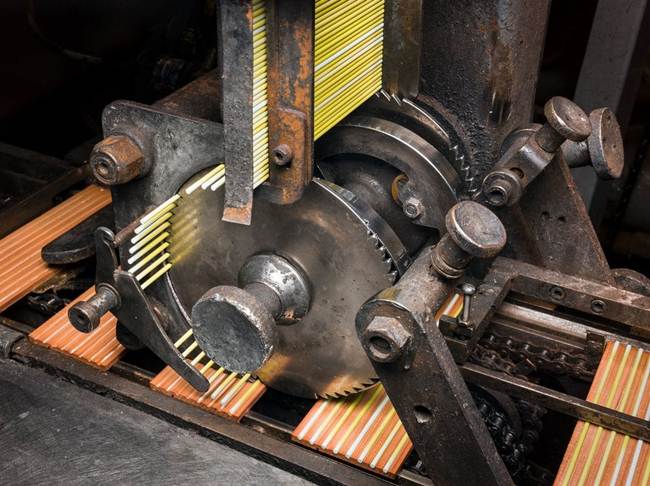One of the oldest and most widely used writing instruments, a pencil, is a very simple thing, consisting of a wooden base and a graphite rod. However, this simplicity of its structure is surprisingly complex for production. Since 1889, General Pencil has turned a huge amount of raw materials (wax, paints, cedar boards, graphite) into products that can be found in art stores and stationery throughout America: watercolor pencils, simple pencils, pastel crayons and much more.
The photographer showed the oldest process of creating pencils » Photographer Christopher Payne visited the plant dozens of times a year, documenting every phase of the production process to create pencils. Now he shared with us a secret that is hidden behind the usual brick walls of the factory.
Recycled graphite, collected for further use

These graphite rods are heated in an oven to remove moisture and solidify the material.

Graphite crumb in consistence resembles sand. It is used to evenly distribute heat from the kiln around graphite rods. After this process, the graphite crumb will be processed.

After heating, the graphite rods are placed in perforated cans and immersed in hot wax.

Cooling of graphite rods after their immersion in heated wax.

The employee in the photo has been working in this factory for 47 years. The mixer behind it processes graphite and charcoal.

Pastel for soft colored pencils is laid manually on corrugated wooden boards, where it is then dried. A special extrusion machine that produced them usually treats one color for a whole week, after which it is cleaned and prepared for a different color.

Pastel rods are very fragile and therefore only laid manually.

With graphite rods is easier – they fit inside the workpiece with a special machine.

Half of the blanks are bonded together with glue and special clamps and dried.

Next, you need to give the workpiece a shape. Woodworking machine cuts and grinds individual pencils to the required shape.

After applying the first layer of paint, the pencils are returned by the conveyor to cover the new layer. Most pencils get four layers of paint.

Ferrule is a metal part on the end of a pencil that attaches to it an eraser.

Special conveyor, which adds pencils ferrules and erasers.

On some pencils instead of a ferrule and an eraser install metal tips.

Sharpening of the finished pencils occurs by rolling them on a high-speed grinding belt.

Pencil is almost ready! Next, the pencils are cleaned and sent to the packaging.

Final: finished products are packed and sent to stores.

Source - General Pencil / StuffmakesmehappyStuffmakesmehappy / Christopher Payne
mind-boggling
LikeLiked by 1 person